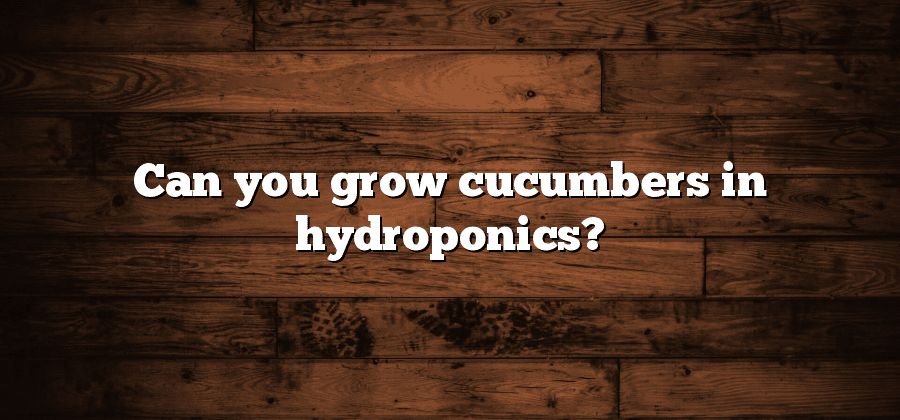Benefits of Growing Cucumbers Hydroponically
One of the key benefits of growing cucumbers hydroponically is the ability to control the growing environment. By eliminating soil and growing the plants in a nutrient-rich water solution, hydroponic systems allow for precise control over factors such as temperature, pH levels, and nutrient concentrations. This level of control ensures that cucumbers receive optimal conditions for growth, leading to healthier plants and higher yields.
Another advantage of growing cucumbers hydroponically is the reduced risk of disease and pests. Soil-borne diseases and pests often pose significant challenges to traditional cucumber cultivation methods. However, in hydroponic systems, the absence of soil eliminates these risks, creating a cleaner and healthier environment for the plants. Moreover, hydroponics allows for the use of integrated pest management techniques, such as introducing beneficial insects or using biological controls, to further minimize the use of chemical pesticides. As a result, growers can enjoy cucumbers that are free from harmful residues, while also contributing to more sustainable and environmentally friendly farming practices.
Suitable Hydroponic Systems for Cucumber Cultivation
Two popular hydroponic systems that are suitable for cucumber cultivation are the nutrient film technique (NFT) and the deep water culture (DWC) system. The NFT system is commonly used for growing cucumbers due to its simplicity and efficiency. In this system, nutrient-rich water is continuously pumped through a sloped channel, allowing the roots of the cucumber plants to be in constant contact with the nutrient solution. This helps to ensure that the plants receive the necessary nutrients for optimal growth. Additionally, the NFT system allows for good aeration and the ability to easily monitor and adjust nutrient levels.
Another suitable hydroponic system for cucumber cultivation is the deep water culture (DWC) system. In this system, cucumber plants are placed in net pots, with their roots suspended in a nutrient-rich solution. Aeration is provided through the use of an air stone or diffuser, which keeps the roots oxygenated and prevents the occurrence of root rot. The DWC system is ideal for cucumber cultivation as it provides ample support for the plants and allows for easy access to the nutrient solution for both the roots and the leaves. Furthermore, the simplicity of this system makes it a popular choice for beginners in hydroponic gardening.
Choosing the Right Cucumber Varieties for Hydroponics
When it comes to choosing the right cucumber varieties for hydroponics, there are a few important factors to consider. First and foremost, you’ll want to choose cultivars that are well-suited for growing in a soilless system. Since hydroponic environments can differ from traditional soil-based gardens, selecting cucumber varieties that are known to perform well in these conditions is crucial for a successful harvest.
One important consideration is the plant’s growth habit. Some cucumber varieties have a bush or compact habit, while others are more vining or sprawling. For hydroponics, it is generally recommended to grow bush or compact cucumber varieties as they require less space and are easier to manage in a controlled environment. Additionally, it is advisable to choose cucumber cultivars that have a high tolerance for diseases and pests, as hydroponic systems can sometimes be more susceptible to such issues.
Another factor to consider when selecting cucumber varieties for hydroponics is the time it takes for the plants to reach maturity. Depending on your specific goals and limitations, you may prefer to grow cucumber varieties that have a shorter growing season. These varieties typically have a faster time to maturity, allowing for quicker yields and a more efficient use of your hydroponic system.
Overall, choosing the right cucumber varieties for hydroponics requires careful consideration of the plant’s growth habit, disease resistance, and maturity time. By selecting cultivars that are well-suited for soilless cultivation and align with your desired goals and limitations, you can maximize your chances of a successful cucumber harvest in your hydroponic garden.
Essential Nutrients for Cucumber Growth in Hydroponics
To ensure healthy and vigorous cucumber growth in a hydroponic system, it is crucial to provide the essential nutrients that the plants need. These nutrients are the building blocks for plant development and play a vital role in their overall productivity. By understanding and carefully managing the nutrient needs of cucumbers, hydroponic growers can optimize their crop’s growth and yield.
First and foremost, cucumbers require three primary macronutrients: nitrogen (N), phosphorus (P), and potassium (K). Nitrogen is essential for promoting leaf and stem growth, while phosphorus aids in root development and flower production. Potassium, on the other hand, is responsible for improving fruit quality and overall plant health. Balancing these macronutrients is crucial, as an imbalance can lead to stunted growth or reduced fruiting. Additionally, cucumbers also require a range of micronutrients, including calcium, magnesium, iron, and manganese, among others, to support metabolic processes and ensure optimal growth.
Optimal pH and Temperature for Cucumber Hydroponics
Maintaining the optimal pH and temperature levels is crucial for the successful cultivation of cucumbers in hydroponics. The pH level refers to the acidity or alkalinity of the nutrient solution, which directly affects the nutrient availability to the plants. In general, cucumbers thrive in a slightly acidic pH range between 5.8 and 6.5. It is important to regularly monitor and adjust the pH levels to ensure that the plants can effectively absorb the necessary nutrients for healthy growth. Deviations from the optimal pH range can lead to nutrient deficiencies, stunted growth, and reduced yields.
Aside from pH, temperature plays a vital role in cucumber hydroponics as it influences various aspects of plant development. Cucumbers prefer a warm environment with temperatures ranging from 70°F to 85°F (21°C to 29°C) during the day and slightly cooler temperatures at night. Outside of these temperature ranges, cucumber plants may experience stress and exhibit decreased productivity. Thus, it is essential to maintain a consistent temperature within the recommended range throughout the growing season. Proper temperature control helps ensure that cucumbers can efficiently absorb nutrients, effectively photosynthesize, and produce high-quality fruits for a successful hydroponic venture.






